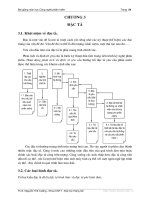Slide công nghệ phần mềm chương 3 project management
Bạn đang xem bản rút gọn của tài liệu. Xem và tải ngay bản đầy đủ của tài liệu tại đây (887.36 KB, 98 trang )
SOFTWARE
ENGINEERING
Chapter 3 - Project Management
Sep 2013
Topics covered
• Risk management
• Managing people
• Project cost
• Project plan & schedule
Chapter 2. Project Management
2
Sep 2013
Chapter 2. Project Management
3
Software project management
• Concerned with activities involved in ensuring
that software is delivered on time and on
schedule and in accordance with the
requirements of the organisations developing
and procuring the software.
• Project management is needed because software
development is always subject to budget and schedule
constraints that are set by the organisation developing the
software.
Sep 2013
Chapter 2. Project Management
4
Success criteria
• Deliver the software to the customer at the agreed time.
• Keep overall costs within budget.
• Deliver software that meets the customer’s expectations.
• Maintain a happy and well-functioning development team.
Sep 2013
5
Chapter 2. Project Management
Bulls-eye Diagram for Project Variables
Target:
100%
cost
Actual:
100%
capability
this
project
Actual:
$90K
duration
Target :
30 wks
Target :
4 defects/Kloc
Actual:
1 defect/Kloc
Target :
$70K
defect
density
Actual:
20 wks
Sep 2013
Chapter 2. Project Management
6
Software management distinctions
• The product is intangible.
• Software cannot be seen or touched. Software project managers
cannot see progress by simply looking at the artifact that is being
constructed.
• Many software projects are 'one-off' projects.
• Large software projects are usually different in some ways from
previous projects. Even managers who have lots of previous
experience may find it difficult to anticipate problems.
• Software processes are variable and organization
specific.
• We still cannot reliably predict when a particular software process
is likely to lead to development problems.
Sep 2013
Chapter 2. Project Management
7
Management activities
• Project planning
• Project managers are responsible for planning. estimating and
scheduling project development and assigning people to tasks.
• Reporting
• Project managers are usually responsible for reporting on the
progress of a project to customers and to the managers of the
company developing the software.
• Risk management
• Project managers assess the risks that may affect a project,
monitor these risks and take action when problems arise.
Sep 2013
Chapter 2. Project Management
8
Management activities
• People management
• Project managers have to choose people for their team and
establish ways of working that leads to effective team performance
• Proposal writing
• The first stage in a software project may involve writing a proposal
to win a contract to carry out an item of work. The proposal
describes the objectives of the project and how it will be carried out.
Sep 2013
Chapter 2. Project Management
9
Risk management
• Risk management is concerned with identifying risks and
drawing up plans to minimise their effect on a project.
• A risk is a probability that some adverse circumstance will
occur
• Project risks affect schedule or resources;
• Product risks affect the quality or performance of the software
being developed;
• Business risks affect the organisation developing or procuring the
software.
Sep 2013
Chapter 2. Project Management
10
Examples of common project, product,
and business risks
Risk
Affects
Description
Staff turnover
Project
Experienced staff will leave the project before it is
finished.
Management change
Project
There will be a change of organizational
management with different priorities.
Hardware unavailability
Project
Hardware that is essential for the project will not
be delivered on schedule.
Requirements change
Project and product
There will be a larger number of changes to the
requirements than anticipated.
Specification delays
Project and product
Specifications of essential interfaces are not
available on schedule.
Size underestimate
Project and product
The size of the system has been underestimated.
CASE tool
underperformance
Product
CASE tools, which support the project, do not
perform as anticipated.
Technology change
Business
The underlying technology on which the system
is built is superseded by new technology.
Product competition
Business
A competitive product is marketed before the
system is completed.
Sep 2013
Chapter 2. Project Management
The risk management process
• Risk identification
• Identify project, product and business risks;
• Risk analysis
• Assess the likelihood and consequences of these risks;
• Risk planning
• Draw up plans to avoid or minimise the effects of the risk;
• Risk monitoring
• Monitor the risks throughout the project;
11
Sep 2013
Chapter 2. Project Management
The risk management process
12
Sep 2013
Chapter 2. Project Management
13
Risk identification
• May be a team activities or based on the individual project
manager’s experience.
• A checklist of common risks may be used to identify risks
in a project
• Technology risks.
• People risks.
• Organisational risks.
• Requirements risks.
• Estimation risks.
Sep 2013
Chapter 2. Project Management
14
Examples of different risk types
Risk type
Possible risks
Technology
The database used in the system cannot process as many transactions per
second as expected. (1)
Reusable software components contain defects that mean they cannot be reused
as planned. (2)
People
It is impossible to recruit staff with the skills required. (3)
Key staff are ill and unavailable at critical times. (4)
Required training for staff is not available. (5)
Organizational
The organization is restructured so that different management are responsible for
the project. (6)
Organizational financial problems force reductions in the project budget. (7)
Tools
The code generated by software code generation tools is inefficient. (8)
Software tools cannot work together in an integrated way. (9)
Requirements
Changes to requirements that require major design rework are proposed. (10)
Customers fail to understand the impact of requirements changes. (11)
Estimation
The time required to develop the software is underestimated. (12)
The rate of defect repair is underestimated. (13)
The size of the software is underestimated. (14)
Sep 2013
Chapter 2. Project Management
15
Risk analysis
• Assess probability and seriousness of each risk.
• Probability may be very low, low, moderate, high or very
high.
• Risk consequences might be catastrophic, serious,
tolerable or insignificant.
Sep 2013
Chapter 2. Project Management
16
Risk types and examples
Risk
Probability
Effects
Organizational financial problems force reductions in the Low
project budget (7).
Catastrophic
It is impossible to recruit staff with the skills required for the High
project (3).
Catastrophic
Key staff are ill at critical times in the project (4).
Moderate
Serious
Faults in reusable software components have to be repaired Moderate
before these components are reused. (2).
Serious
Changes to requirements that require major design rework Moderate
are proposed (10).
Serious
The organization is restructured so that
management are responsible for the project (6).
Serious
different High
The database used in the system cannot process as many Moderate
transactions per second as expected (1).
Serious
Sep 2013
Chapter 2. Project Management
17
Risk types and examples
Risk
The time required
underestimated (12).
Probability
to
develop
the
software
is High
Software tools cannot be integrated (9).
High
Effects
Serious
Tolerable
Customers fail to understand the impact of requirements Moderate
changes (11).
Tolerable
Required training for staff is not available (5).
Moderate
Tolerable
The rate of defect repair is underestimated (13).
Moderate
Tolerable
The size of the software is underestimated (14).
High
Tolerable
Code generated by code generation tools is inefficient (8).
Moderate
Insignificant
Sep 2013
Chapter 2. Project Management
18
Risk planning
• Consider each risk and develop a strategy to manage that
risk.
• Avoidance strategies
• The probability that the risk will arise is reduced;
• Minimisation strategies
• The impact of the risk on the project or product will be reduced;
• Contingency plans
• If the risk arises, contingency plans are plans to deal with that risk;
Sep 2013
Chapter 2. Project Management
19
Strategies to help manage risk
Risk
Strategy
Organizational financial Prepare a briefing document for senior management
problems
showing how the project is making a very important
contribution to the goals of the business and presenting
reasons why cuts to the project budget would not be costeffective.
Recruitment problems
Alert customer to potential difficulties and the possibility of
delays; investigate buying-in components.
Staff illness
Reorganize team so that there is more overlap of work and
people therefore understand each other’s jobs.
Defective components
Replace potentially defective components with bought-in
components of known reliability.
Requirements changes Derive traceability information to assess requirements
change impact; maximize information hiding in the design.
Sep 2013
Chapter 2. Project Management
Strategies to help manage risk
Risk
Strategy
Organizational
restructuring
Prepare a briefing document for senior management
showing how the project is making a very important
contribution to the goals of the business.
Database
performance
Investigate the possibility of buying a higher-performance
database.
Underestimated
development time
Investigate buying-in components; investigate use of a
program generator.
20
Sep 2013
Chapter 2. Project Management
21
Risk monitoring
• Assess each identified risks regularly to decide whether or
not it is becoming less or more probable.
• Also assess whether the effects of the risk have changed.
• Each key risk should be discussed at management
progress meetings.
Sep 2013
Chapter 2. Project Management
22
Risk indicators
Risk type
Potential indicators
Technology
Late delivery of hardware or support software; many reported
technology problems.
People
Poor staff morale; poor relationships amongst team members; high staff
turnover.
Organizational
Organizational gossip; lack of action by senior management.
Tools
Reluctance by team members to use tools; complaints about CASE
tools; demands for higher-powered workstations.
Requirements
Many requirements change requests; customer complaints.
Estimation
Failure to meet agreed schedule; failure to clear reported defects.
Sep 2013
Chapter 2. Project Management
23
Managing people
• People are an organisation’s most important assets.
• The tasks of a manager are essentially people-oriented.
Unless there is some understanding of people,
management will be unsuccessful.
• Poor people management is an important contributor to
project failure.
Sep 2013
Chapter 2. Project Management
24
People management factors
• Consistency
• Team members should all be treated in a comparable way without
favourites or discrimination.
• Respect
• Different team members have different skills and these differences
should be respected.
• Inclusion
• Involve all team members and make sure that people’s views are
considered.
• Honesty
• You should always be honest about what is going well and what is
going badly in a project.
Sep 2013
Chapter 2. Project Management
25
Motivating people
• An important role of a manager is to motivate the people
working on a project.
• Motivation means organizing the work and the working
environment to encourage people to work effectively.
• If people are not motivated, they will not be interested in the work
they are doing. They will work slowly, be more likely to make
mistakes and will not contribute to the broader goals of the team or
the organization.
• Motivation is a complex issue but it appears that their are
different types of motivation based on:
• Basic needs (e.g. food, sleep, etc.);
• Personal needs (e.g. respect, self-esteem);
• Social needs (e.g. to be accepted as part of a group).









